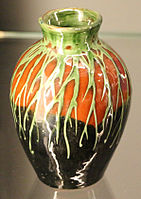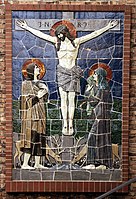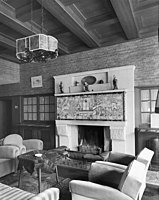Max Laeuger

Max Laeuger(30 September 1864 – 12 December 1952) was a Germanarchitect,artist, andceramicist.He was born and died inLörrach,Baden-Württemberg.[1]
Working initially in anArt Nouveaustyle, he was perhaps the most important figure in the relatively small German contribution to theart potterymovement, though he was a designer and decorator rather than a hands-on potter. As an architect he specialized in comfortable private houses, parks and public gardens, mostly in Germany. He was one of the founders of theDeutscher Werkbundin 1907.[2]
Life[edit]

From 1881 to 1884 he studied painting and interior design at the school of decorative arts inKarlsruhe,and was later professor of interior and garden design at the university there (now theKarlsruhe Institute of Technology) from 1894 until 1933. In German sources he is often given his professorial title, in the German way. He travelled to Italy in 1891, and then lived in Paris, where he studied painting at the privateAcadémie Julianin 1891–92. Other major travels were to Rome and North Africa in 1905, and Spain, studying Islamic ceramics there, in 1912.[3]
Between 1937 and 1939 he published a history of art in three volumes.[4]
Pottery[edit]

| Olympic medal record | ||
|---|---|---|
| Art competitions | ||
| 1928 Amsterdam | Town planning | |
He first became interested in pottery in 1885, visiting the Mayer pottery in Karlsruhe, and another, Manufakture Tonwerke, inKandernin theBlack Forest.He began to have his designs produced in Kandern from 1897, whenArt Nouveauwas already the dominant style trend, and continued to use the pottery there until 1914. By 1898 his pieces were on sale at the Paris shop ofSiegfried Bing,"Maison de l'Art Nouveau"(" House of New Art "), which had given the movement its name. Later his works were sold at the German criticJulius Meier-Graefe's competitive gallery in Paris, La Maison Moderne (1897–1903).[5]
His works won gold medals at both the ParisExposition Universelle (1900)and theSt. Louis World's Fairin 1904.[6]These and smaller events were important for raising the profile of potters, especially those working in backwoods locations. Much later, in 1928 he won a bronze medal in the art competitions of theAmsterdam Olympic Gamesfor hisHamburg Stadtpark.[7][8]
In 1916 he took over the former premises of the Staatliche Majolika Manufaktur Karlsruhe to create his own pottery atelier; this was destroyed by Allied bombing in 1944,[9]after which (at the age of 80) he returned to Lörrach for his remaining years.
-
Vase, Kandern, 1898-1900
-
Vase, Kandern, c. 1900
-
Vase, Kandern, 1900, for the ParisExposition Universelle (1900)
-
Vase, Kandern, 1910
-
CeramicCrucifixionrelief for a church inLörrach
Architecture and other work[edit]

He designed several large garden and park projects. Perhaps his major commission was for the huge villaHet Kareol,allegedly the largest private house built in theNetherlandsin the 20th century, demolished in 1979, though some fragments survive. He started work there in 1907, and the project was completed in 1911. As well as the house, he designed the tiling which was a prominent feature of both the interior and exterior, and also the large gardens, now a public park. The Villa Küchlin inHorbenin the Black Forest was another country house, still rather large, and he designed a number of other houses for the wealthy.[10]
TheHamburg Stadtparkwas a highly prestigious commission, designed to giveHamburga large central park along the lines ofMunich'sEnglischer Garten,Berlin'sTiergarten,London'sHyde ParkandRegent's Park,or New York'sCentral Park.A contest was held in 1908 for designs, which became bedevilled by "conflicts and secret maneuvers", exposing differing views on park design, as well as personal rivalries. No first prize was given, but Laeuger's design was one of three second prizes. After a period of tussling between several figures, including some very underhand dealing by the youngLeberecht Migge,a compromise scheme was adopted, which pleased nobody. Laeuger rather bitterly saw it as his scheme stripped of some of its more architectural and expensive elements.[11]
Between 1909 and 1912 he worked on the Gönneranlage estate inBaden-Baden,whose gardens, filled with sculpture and roses, are now a public park.[12]From 1922 to 1925 he worked on the existing Wasserkunstanlage Paradies ( "Paradise water-garden" ), also in Baden-Baden, notably adding a sloping cascade of water in a sinuous Art Nouveau style. The Max-Laeuger Platz by the entrance is named in his honour.[13]
In 1933 he designed a public memorial inMannheimforCarl Benz(1844–1929), founder ofMercedes-Benz.Benz was an alumnus of theKarlsruhe Institute of Technologywhere Laeuger was a professor, and Laeuger also designed the architectural setting for a bust there of the former professorHeinrich Hertz,after whom the electrical unit is named. He designedstained-glasswindows forSt. Paul's Church, Basel.[14]
-
Interior atHet Kareol,with tile panel
-
Villa Küchlin,Horben
-
Gönneranlage gardens
-
The cascade at Wasserkunstanlage Paradies
-
Drawing for a residential development inHorben,1907
Notes[edit]
- ^Opac; NDB
- ^NDB; Junghanns, Kurt,Der Deutsche Werkbund. Sein erstes Jahrzehnt.,p. 140, 1982, Berlin
- ^Opac; NDB
- ^Opac
- ^Opac
- ^Opac
- ^Max Laeuger's profile at Sports Reference
- ^"Max Laeuger".Olympedia.Retrieved22 July2020.
- ^Opac
- ^NDB
- ^Haney, 55–60
- ^Herrmann, Barbara,Baden-Baden, deine Mystik ist die Eleganz: Ein lebendiger Spaziergang in die Gegenwart mit einem Blick in die Vergangenheit(in German), 2016, TWENTYSIX, ISBN3-7407-0617-1,9783740706173,google books;NDB
- ^Park website
- ^"Paulus Church, Basel, Switzerland".All About Switzerland.Retrieved4 September2010.
References[edit]
- Haney, David,When Modern Was Green: Life and Work of Landscape Architect Leberecht Migge,2010, Routledge,ISBN0-415-56138-8,9780415561389,google books
- "NDB" *Elisabeth Kessler-Slotta (1982),"Laeuger, Max",Neue Deutsche Biographie(in German), vol. 13, Berlin: Duncker & Humblot, pp. 405–406;(full text online)
- "Opac":"Max Laeuger",Les Arts décoratifs, Centre de documentation des musées (in French)
- DatabaseOlympics profile
- Bio with image[permanent dead link]
Further reading[edit]
- Reinald Eckert:Zwei Parkanlagen des frühen 20. Jahrhunderts in Baden-Baden. Die Gönner-Anlage und das Paradies von Max Laeuger.In:Die Gartenkunst,1 (2/1989), pp. 266–278.
- Elisabeth Kessler-Slotta:Max Laeuger (1864–1952). Sein graphisches, kunsthandwerkliches und keramisches Oeuvre.Saarbrücken 1985.
- Arthur Mehlstäubler (Bearb.)Max Laeuger. Gesamt Kunst Werk.(Ausstellungskatalog) Badisches Landesmuseum, Karlsruhe 2014 / Dreiländermuseum, Lörrach 2014/2015.
- Markus Moehring, Elke Seibert (Hrsg.):Max Laeuger. Die Sammlung in Lörrach.(=Lörracher Hefte, Rote Schriftenreihe des Museums am Burghof(now Dreiländermuseum), Heft 13.) Lörrach 2011.
- Ulrich Maximilian Schumann:Das Phänomen Max Laeuger. Diplomatie im Auftrag der Kunst.In: Urs Robert Kaufmann (Hrsg.):Die Schweiz und der Deutsche Südwesten.(=Oberrheinische Studien,Vol 25.) Ostfildern 2006,ISBN3-7995-7825-0,pp. 155–169
External links[edit]
- Literature by and about Max Laeugerin theGerman National Librarycatalogue
- Max Laeuger (1864–1952)(in German) saai.kit.edu
- Max Laeugerartnet
- Max Laeuger (1864–1952)(in German) Dreiläendermuseum
- Max Laeuger (1864–1952)(in German)Baden-Baden
- 1864 births
- 1952 deaths
- 19th-century German architects
- Olympic bronze medalists in art competitions
- Académie Julian alumni
- Medalists at the 1928 Summer Olympics
- German ceramists
- Art Nouveau architects
- German landscape architects
- Olympic competitors in art competitions
- 20th-century German architects
- People from Lörrach










